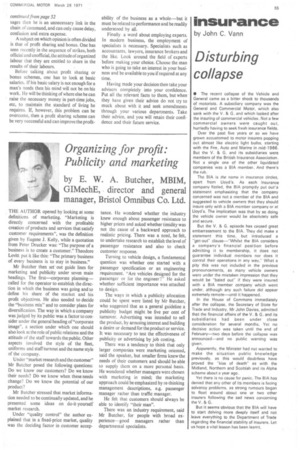insurance
Page 57

If you've noticed an error in this article please click here to report it so we can fix it.
by John C Vann
Disturbing collapse
• The recent collapse of the Vehicle and General came as a bitter shock to thousands of motorists. A subsidiary company was the General and Commercial Motor, which also sank with the V. & G. and which looked after the insuring of commercial vehicles. Not a few commercial owners were caught out, hurriedly having to seek fresh insurance fields.
Over the past five years or so we have grown accustomed to motor insurers popping out almost like electric light bulbs, starting with the Fire, Auto and Marine in mid-1966. But the V. & G. and its subsidiaries were members of the British Insurance Association. Not a single one of the other liquidated companies was a BIA member. And there's the rub.
The BIA is the name in insurance circles, apart from Lloyd's. As each insurance company fizzled, the BIA promptly put out'a statement emphasizing that the company concerned was not a member of the BIA and suggested to vehicle owners that they should insure only with a BIA member company or at Uoyd's. The implication was that by so doing the vehicle owner would be absolutely safe and secure.
But the V. & G. episode has caused great embarrassment to the BIA. They did make a statement this time, but introduced a "get-out" clause—"Whilst the BIA considers a company's financial position before admitting it to membership, it does not guarantee individual members nor does it control their operations in any way." What a pity this was not included in the previous pronouncements, as many vehicle owners were under the mistaken impression that they would be "baled out" if they were insured with a BIA member company which went under, although any such failure did appear extremely remote—until it happened.
In the House of Commons immediately after the collapse, the Secretary of State for Trade and Industry, Mr John Davies, admitted that the financial affairs of the V. & G. and its subsidiaries had been under close consideration for several months. Yet no decisive action was taken until the end of February—two days before the collapse was announced—and no public warning was given.
Apparently, the Minister had not wanted to make the situation public knowledge previously, as this would doubtless have proved the "kiss of death" as with the Midland, Northern and Scottish and its Alpha scheme about a year ago.
Yet there is no cause for panic. The BIA has denied that any other of its members is facing solvency problems, as strong rumours began to float around about one or two other insurers following the sad news concerning the V. & G.
But it seems obvious that the BIA will have to start delving more deeply itself and not leave everything to the Department of Trade regarding the financial stability of insurers. Let us hope a vital lesson has been learnt.














































































































